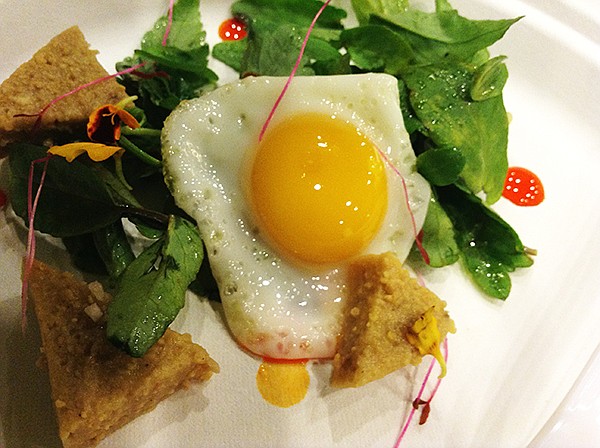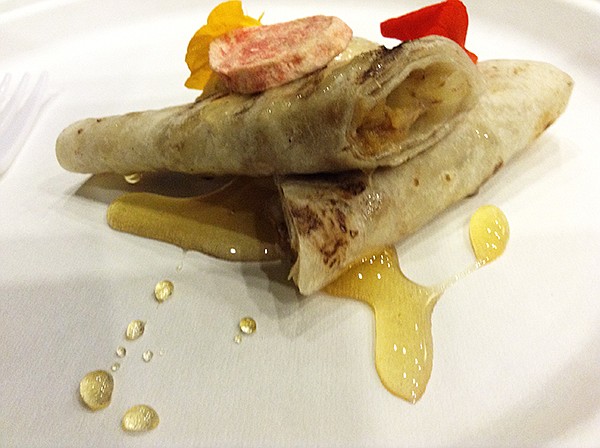 Facebook
Facebook
 X
X
 Instagram
Instagram
 TikTok
TikTok
 Youtube
Youtube

Tipoff from my friend Ed: “Haute Kumeyaay Cuisine. Barona. Be there or be square.”
“There” is at Barona’s Cultural Center. This Mexican pop-up chef, Gilberto Morales, who created his Baja-based Restaurante Nomada — Cocina Itinerante, has been spending the past few years visiting Kumeyaay communities in Baja, mainly at San Antonio de las Minas, in the mountains between Ensenada and San Felipe, getting to know the people, and their food. And this night, he’s offering a dinner, Kumeyaay-style.

Maybe fifty people turn up. Everything from college professors to local ranch workers. Many Kumeyaay. Morales starts by explaining the importance of shawii, acorn paste. “It’s like the rice, or the wheat of the Kumeyaay world,” he says. “Like rice, it’s tasteless, but the trick is to combine it with something tasty.”
So the first dish is a siñaw kuatay salad. Cilantro greens, beet, shawii (acorn mush), with quail egg and chili oil. Yes, the shawii is pretty tasteless, but you combine it with the red chile and yellow nasturtiums and chili oil, and it starts to get interesting.
Then comes rabbit with sage butter and pickled pear cactus, along with cilantro, red onion, date, and quince vinaigrette. Tasty. Date’s to sweeten it up.
He emphasizes this is his interpretation of Kumeyaay, meaning not totally Kumeyaay. The dates, for instance. But there are certain rules he has to recognize. Like the acorn paste. “It is a holy food.” The ancestors are involved. The preparer must be alone. “If someone watches, it ruins it,” he says.
Next up, duck, bean, and wheat stew, with a mole yumano (a combo of acorn, pine nuts, sage, dates, and red chili sauce, plus watercress.) These are small samples, but they add up. And they are all lean and healthy.

“You’ll notice no salt, no cooking in fat. The Kumeyaay traditionally had none,” he says.
He has been experimenting on customers in his pop-up restaurants in Baja, in Ensenada, and the Guadalupe Valley. And winning culinary contests, up and down the Californias.
The most delicious is the dessert, which has shawii, cacao cheese, mespow kumulsh (local honey) wrapped in a flour tortilla, along with freeze-dried fruits, accompanied by acorn coffee. Surprising tastes, with the rich native bee honey, and this nutty coffee.
Morales emphasizes this cuisine is not to be confused with the famous Baja Med movement.
“We’ve been hearing about that for so long,” he says. “But what I discovered when I spoke with some of their celebrity chefs, about what I was doing, learning from the people who had been eating here for 12,000 years, they said no, that was not what they were about. ‘We are the Fathers of Baja Med,’ they said. They wanted to create their food clean-slate. No ancestors. Not interested. I was the opposite. I wanted to connect with the foods the Kumeyaay had survived on and created. No outsider had done that before, as far as I knew.”


Tipoff from my friend Ed: “Haute Kumeyaay Cuisine. Barona. Be there or be square.”
“There” is at Barona’s Cultural Center. This Mexican pop-up chef, Gilberto Morales, who created his Baja-based Restaurante Nomada — Cocina Itinerante, has been spending the past few years visiting Kumeyaay communities in Baja, mainly at San Antonio de las Minas, in the mountains between Ensenada and San Felipe, getting to know the people, and their food. And this night, he’s offering a dinner, Kumeyaay-style.

Maybe fifty people turn up. Everything from college professors to local ranch workers. Many Kumeyaay. Morales starts by explaining the importance of shawii, acorn paste. “It’s like the rice, or the wheat of the Kumeyaay world,” he says. “Like rice, it’s tasteless, but the trick is to combine it with something tasty.”
So the first dish is a siñaw kuatay salad. Cilantro greens, beet, shawii (acorn mush), with quail egg and chili oil. Yes, the shawii is pretty tasteless, but you combine it with the red chile and yellow nasturtiums and chili oil, and it starts to get interesting.
Then comes rabbit with sage butter and pickled pear cactus, along with cilantro, red onion, date, and quince vinaigrette. Tasty. Date’s to sweeten it up.
He emphasizes this is his interpretation of Kumeyaay, meaning not totally Kumeyaay. The dates, for instance. But there are certain rules he has to recognize. Like the acorn paste. “It is a holy food.” The ancestors are involved. The preparer must be alone. “If someone watches, it ruins it,” he says.
Next up, duck, bean, and wheat stew, with a mole yumano (a combo of acorn, pine nuts, sage, dates, and red chili sauce, plus watercress.) These are small samples, but they add up. And they are all lean and healthy.

“You’ll notice no salt, no cooking in fat. The Kumeyaay traditionally had none,” he says.
He has been experimenting on customers in his pop-up restaurants in Baja, in Ensenada, and the Guadalupe Valley. And winning culinary contests, up and down the Californias.
The most delicious is the dessert, which has shawii, cacao cheese, mespow kumulsh (local honey) wrapped in a flour tortilla, along with freeze-dried fruits, accompanied by acorn coffee. Surprising tastes, with the rich native bee honey, and this nutty coffee.
Morales emphasizes this cuisine is not to be confused with the famous Baja Med movement.
“We’ve been hearing about that for so long,” he says. “But what I discovered when I spoke with some of their celebrity chefs, about what I was doing, learning from the people who had been eating here for 12,000 years, they said no, that was not what they were about. ‘We are the Fathers of Baja Med,’ they said. They wanted to create their food clean-slate. No ancestors. Not interested. I was the opposite. I wanted to connect with the foods the Kumeyaay had survived on and created. No outsider had done that before, as far as I knew.”
Comments